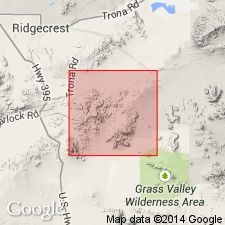
- Usage in publication:
-
- Almond Mountain Volcanics*
- Modifications:
-
- Named
- Dominant lithology:
-
- Breccia
- Tuff
- AAPG geologic province:
-
- Mojave basin
Summary:
Named for Almond Mountain. Type section designated as exposures about 1/3 mi northwest of summit of Almond Mountain [NW/4 NW/4 sec.34 T29S R42E] in south part of Lava Mountains, San Bernardino Co, CA. Includes rocks that were divided by Hulin (1925) between Rosamond Formation and Red Mountain Andesite. Consists of tuff breccia, tuff, lapilli tuff, sandstone, conglomerate, and porphylite. Geologic map divides unit into 9 lithologies in east and west facies which are separated by valley. Rocks of east and west facies though similar clarify depositional pattern from east and west centers to form continuous layer of 75 to 100 sq mi. Type section (900 ft thick) represents only lower half of unit. Intruded into or overlies with angular unconformity middle Pliocene Bedrock Spring Formation (new). Intruded or unconformably overlain by Lava Mountains Andesite (new). Assigned late Pliocene age based on stratigraphic relations.
Source: GNU records (USGS DDS-6; Menlo GNULEX).
For more information, please contact Nancy Stamm, Geologic Names Committee Secretary.
Asterisk (*) indicates published by U.S. Geological Survey authors.
"No current usage" (†) implies that a name has been abandoned or has fallen into disuse. Former usage and, if known, replacement name given in parentheses ( ).
Slash (/) indicates name conflicts with nomenclatural guidelines (CSN, 1933; ACSN, 1961, 1970; NACSN, 1983, 2005, 2021). May be explained within brackets ([ ]).

